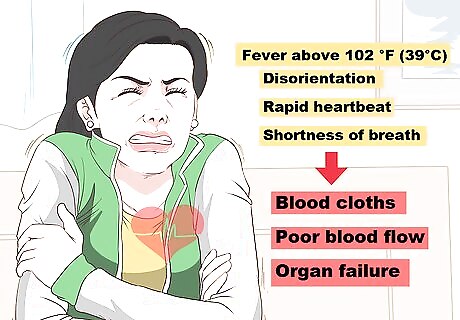
views
X
Trustworthy Source
MedlinePlus
Collection of medical information sourced from the US National Library of Medicine
Go to source
- Look for pimples, boils, or areas of irritated skin that feel hot.
- Check for swollen pockets of skin that are filled with pus.
- Seek medical care immediately if you develop additional symptoms like fever, disorientation, headache, vomiting, or diarrhea.
Diagnosing and Treating Skin Infections

Look for pimples, boils, or areas of red, swollen skin. Skin infections are the most common type of staph infection. They look like pimples, boils, blisters, or areas of swollen, red skin that feels hot. Sometimes, they ooze pus or other discharge. Broken skin is prone to infection. Washing your hands frequently and keeping wounds clean are the best ways to prevent a skin staph infection.

Check for abscesses, or pockets of pus. Abscesses are swollen pockets of skin that are filled with pus. They feel like they’re filled with liquid, rather than a lump of swollen skin, and it usually hurts to touch them. Abscesses that grow increasingly painful and pus seeping from a wound could indicate a bad infection, so call your doctor if you notice these signs.

Wash your hands before and after touching the area. Wash up thoroughly with soap and hot water before you clean the area or change a bandage. You wouldn't want to risk contaminating it further. After treating the infected skin, wash your hands again to prevent spreading germs.

Soak a minor infection 3 times per day and keep it bandaged. Minor abscesses and skin infections often go away on their own with proper home care. Wash the infected area thoroughly, soak it in warm water for 10 minutes 3 times a day, and cover it with a sterile bandage. Change the bandage 2 to 3 times daily or whenever it gets wet. If you’d like, you can add salt to your warm water soaks. Try soaking the infected area in a solution of 1 tablespoon (14.8 ml) of salt and 1 US quart (0.95 L) of warm water. Adding salt to your warm water soaks can help soothe your skin. While salt doesn't kill staph bacteria, it could help deter other contaminants.

Don't attempt to drain an abscess on your own. Avoid touching an infection unless you’re treating it. Remember to wash your hands before and after providing treatment. If you have an abscess, leave it alone and don't try to drain or pop it. Scratching an infection or popping an abscess could further contaminate the area and spread germs.

See your doctor promptly if you have signs of a serious skin infection. Minor swelling or redness often go away on their own in a day or two, provided you keep the wound clean. However, if pain, swelling, or abscesses get worse, or if you have a fever, you should see your doctor as soon as possible. Only a doctor can accurately diagnose a staph infection and prescribe the appropriate treatment. Keep the area covered with a sterile bandage until you can see a doctor.
Recognizing Internal Infections

Get rest and drink plenty of fluids if you have food poisoning. Staph bacteria are a common cause of food poisoning. Symptoms include nausea, vomiting, and diarrhea and, when caused by staph, usually subside in a day or so. Call your doctor if you don’t feel better within 24 to 48 hours. In the meantime, avoid overexerting yourself and drink plenty of water, sports drinks, or Pedialyte to stay hydrated. Try to keep down plain rice, soup or broth, and other bland foods. Wash your hands frequently to help prevent spreading germs, especially if you’re vomiting or have diarrhea.

See your doctor if you think you might have septic arthritis. Septic arthritis is a joint infection often caused by staph bacteria. Schedule an appointment with your doctor if you experience symptoms such as intense joint pain, redness, swelling, and fever. Infections typically occur in the knees, ankles, or toes and, usually, only one joint is affected. Symptoms of septic arthritis develop suddenly. In other forms of arthritis, joint pain and swelling develop gradually, often occur at distinct times during the day, and typically affect more than one joint. Your doctor will perform an examination and take a bacterial culture. They’ll aspirate the joint, or remove excess fluid to decrease swelling. If they determine you have an infection, they’ll inject medication into the joint or prescribe oral antibiotics.

Seek emergency medical care for signs of toxic shock syndrome (TSS). TSS can occur when staph bacteria spread to the bloodstream and internal organs. Symptoms include fever above 102 °F (39 °C), disorientation, headache, vomiting, diarrhea, and a red rash on the bottoms of the hands and feet. TSS is a medical emergency and requires immediate care. It can result from using a tampon for longer than the recommended amount time or from an infected burn, wound, or surgical site.

Get immediate help if you have symptoms of sepsis. Sepsis is a serious condition caused by the body’s immune response to a widespread bacterial infection. Symptoms include fever above 102 °F (39 °C), chills, disorientation, rapid heartbeat, and shortness of breath. Without prompt treatment, sepsis can lead to blood clots, poor blood flow, and organ failure. Sepsis is a medical emergency, so you need to go to the hospital as soon as possible if you have an infection that isn’t healing and have symptoms of sepsis. While anyone can develop sepsis, it’s more likely to occur in people with compromised immune systems, infants, the elderly, people with chronic illnesses (such as kidney or liver disease), and after a serious burn or injury.
Seeking Medical Treatment

See your doctor if you have serious or worsening symptoms. If a skin infection worsens, doesn't heal, or you develop serious symptoms, such as a fever, seek medical attention. While life-threatening infections are uncommon, even a minor skin infection can lead to major health concerns when not properly treated. It’s especially important to see a doctor if you have a weakened immune system, a chronic illness, are elderly, or have a severe burn or wound. If your infant or young child has an infection that won’t heal or develops a high fever, they need to see a doctor.

Get a physical exam and bacterial culture. When you see the doctor, they’ll perform an exam and ask you how and when your symptoms began. They’ll likely order a bacterial culture to identify the specific cause of the infection. If you have a skin infection, they’ll swab the area or take a sample of tissue or pus. For TSS or sepsis, doctors test blood samples for bacteria and take a white blood cell count, but treatment often begins before the results become available. Because these conditions are so serious, antibiotics and IV (intravenous) fluids need to be administered as soon as possible.

Have any skin lesions or abscesses drained. If you have a skin infection and developed an abscess, your doctor might need to drain it. They’ll numb the area, make a small cut to let the pus seep out, then dress it with gauze. Follow your doctor’s care instructions after having an abscess drained. Clean the area 2 to 3 times daily, apply medicated ointment if your doctor advises, and dress the area with a clean bandage. Change the bandage 2 to 3 times per day or whenever it gets wet.

Take any prescribed medications as directed. Staph infections that don't heal with home care are treated with antibiotics. Take your medication according to your doctor’s instructions, and don’t stop taking it even if you feel better. If you stop taking antibiotics prematurely, the infection could come back or worsen. Additionally, your doctor might recommend taking a pain reliever to combat swelling, fever, and other related symptoms.

Tell your doctor if your symptoms don’t improve. Staph bacteria can adapt quickly, and many strains have become resistant to some antibiotics. Bacterial cultures help doctors choose the right antibiotics, and you should start to feel better within a couple of days. If you don’t, call your doctor and discuss alternative medications. They might recommend stronger IV (intravenous) antibiotics.

















Comments
0 comment